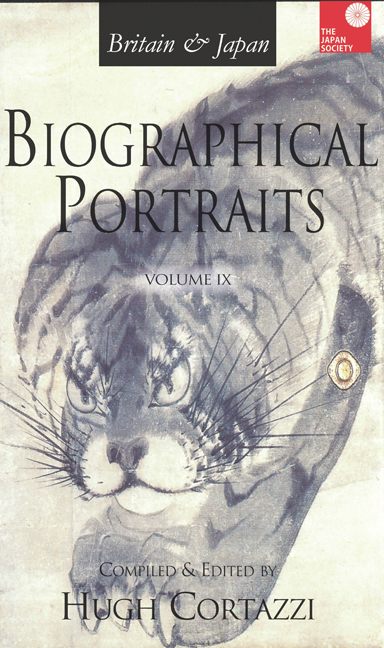Book contents
- Frontmatter
- Contents
- Introduction
- List of Contributors
- Index of Biographical Portraits in Japan Society Volumes
- PART I JAPAN IN BRITAIN: THINGS JAPANESE
- PART II BRITAIN IN JAPAN: TRADE
- BRITISH ACTIVITIES
- MISSIONARIES
- MUSIC, DRAMA AND FILM
- EPISODE
- PAINTERS
- JOURNALISTS
- JAPANESE WOMEN PIONEERS
- PART III SCHOLARS AND WRITERS: JAPANESE
- BRITISH
- PART IV POLITICIANS AND OFFICIALS: JAPANESE
- BRITISH OFFICERS
- BRITISH JUDGES AND A DIPLOMAT
- BRITISH POLITICAL FIGURES
- Index
17 - Bishop Kenneth Sansbury (1905–1993): College Lecturer and Chaplain
Published online by Cambridge University Press: 30 April 2022
- Frontmatter
- Contents
- Introduction
- List of Contributors
- Index of Biographical Portraits in Japan Society Volumes
- PART I JAPAN IN BRITAIN: THINGS JAPANESE
- PART II BRITAIN IN JAPAN: TRADE
- BRITISH ACTIVITIES
- MISSIONARIES
- MUSIC, DRAMA AND FILM
- EPISODE
- PAINTERS
- JOURNALISTS
- JAPANESE WOMEN PIONEERS
- PART III SCHOLARS AND WRITERS: JAPANESE
- BRITISH
- PART IV POLITICIANS AND OFFICIALS: JAPANESE
- BRITISH OFFICERS
- BRITISH JUDGES AND A DIPLOMAT
- BRITISH POLITICAL FIGURES
- Index
Summary
BACKGROUND
KENNETH SANSBURY WAS born in London and educated at St. Paul's School, from where he won a Scholarship to Peterhouse College, Cambridge. For his first year he studied Classics before switching to Theology, in which he gained a double First. He went on to train for the priesthood at Westcott House in Cambridge.
It was while he was still a student at Cambridge that he applied to the Society for the Propagation of the Gospel (SPG) to become a missionary in Japan. He was inspired to do this by attending a missionary rally at which Bishop Joseph Motoda, the first Japanese Bishop of Tokyo, was one of the speakers. Bishop Motoda made clear that while the expectation was that the Nippon Sei Kō Kai (NSKK), the Anglican Church in Japan, would become independent of overseas support in due course, it was as yet a very young church and was not yet ready to stand on its own feet. He therefore appealed for missionaries to come from England and Kenneth responded to that call.
Though Kenneth had been accepted for missionary work in Japan he could not set out until he had been ordained, first as a deacon and then as a priest, and had completed one curacy in England. He served his curacy at Dulwich Common between 1928 and 1931 and in July 1931 he married Ethelreda Wamsley, who was a fellow student at Cambridge and whom he had first met at a missionary breakfast there.
Kenneth and Ethelreda expected to sail for Japan by the end of the year, but England came off the Gold Standard in the autumn of 1931 and Bishop Matsui, Bishop Motoda's successor, sent a telegram to say that no further staff should come from England until that situation was resolved. So Kenneth was found a temporary curacy in Wimbledon and it was not until the spring of 1932 that Kenneth and Ethelreda set sail for Yokohama.
It was as they passed through Shanghai that they saw some of the repercussions of Japan's invasion of Manchuria, which had begun in the previous September. As they passed Woosung they saw the site of forts overlooking the bay, which the Chinese had built and which the Japanese had now destroyed, and in the crowded district of Chapei they saw the devastation caused by Japanese bombing.
- Type
- Chapter
- Information
- Britain & Japan Biographical Portraits Vol IX , pp. 197 - 206Publisher: Amsterdam University PressPrint publication year: 2015



